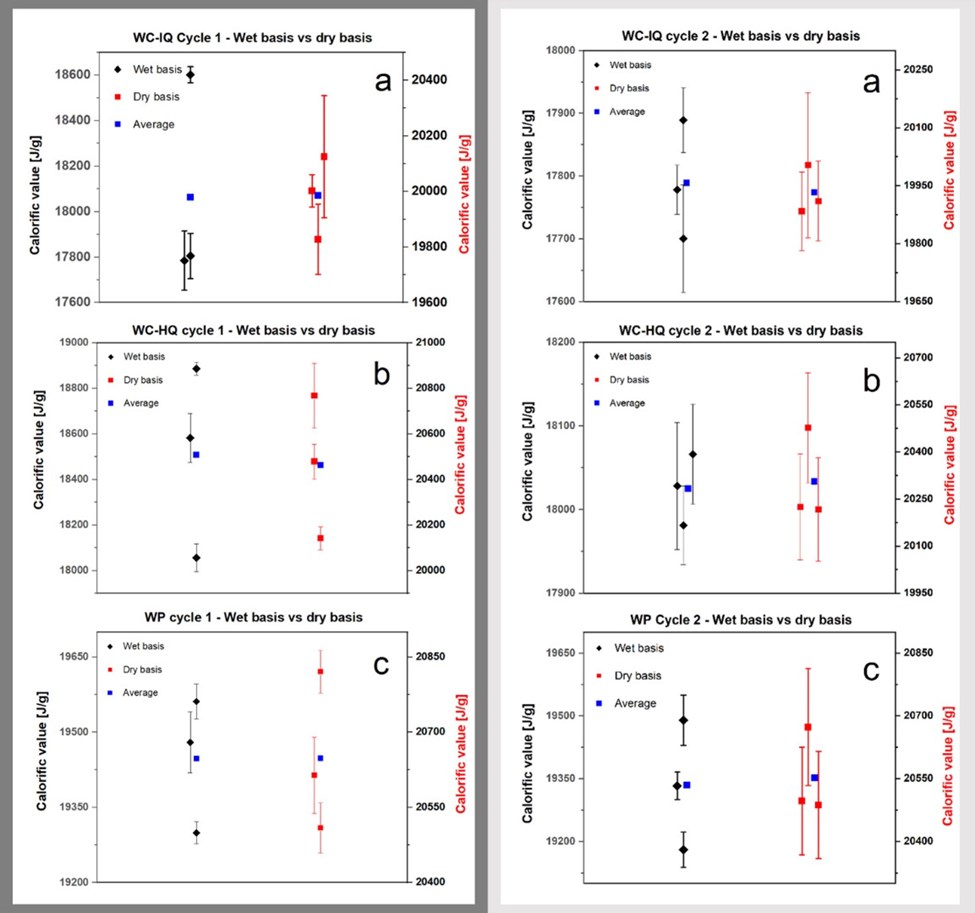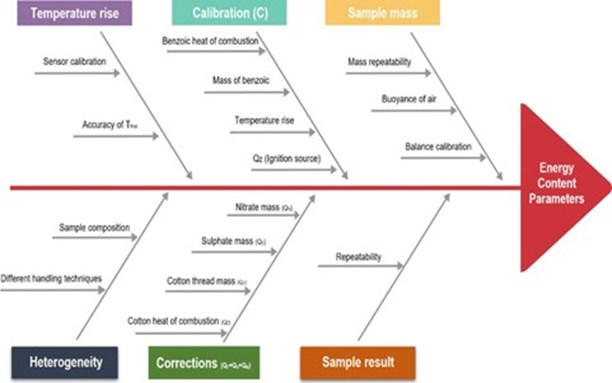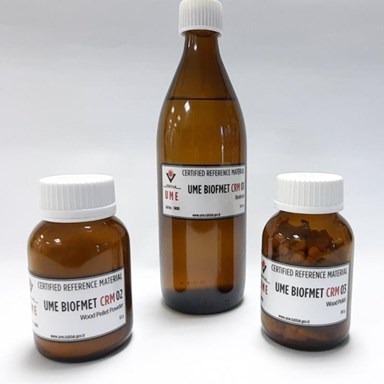Objective 3: Traceable determination of the calorific value of solid biofuels by measurement of the ash content
To traceably determine the calorific value of the solid biofuels by developing validated methods for the online measurement of ash content. In addition, to develop accurate methods < 0.1% absolute repeatability and < 0.2% absolute reproducibility (as per EN ISO 18122) for determining the amount and composition of ash content in the measurement range 0% – 1.2%.
Knowing the calorific value of biofuels is important to establish the energy content and regulate its combustion, as well as for fiscal billing of the fuel. In combination with the calorific value, the moisture content of solid biofuels determines the efficiency of the CHP and the biorefinery plants and is used to optimize the processes of such facilities. Therefore, with the increased shift towards a biobased economy, the biomass cost and its physical properties must be precisely determined.
Ash content quantification and its qualification are needed to gain insight into the possibility of slag formation, which may have significant economic consequences related to cleaning up after an incidence and it may lead to serious problems in the stability of the energy supply if a CHP is shut down. In addition, during the handling of the waste and deposition as such, it is important to have measurement techniques that provide information about the total amount and composition of the ash.
Traceability of the online measured calorific value can be achieved through the reference material developed in the project (reported below) with known energy content. The energy content of the reference materials was determined by bomb calorimetry using benzoic acid as primary calibration standard. To guarantee the most accurate measurement values and to create an enhanced technological methodology for the measurements of biofuels’ calorific value, in a first stage an interlaboratory comparison on the calorific value of solid and liquid biofuels was realized with three different project partners, namely PTB, BRML and TUBITAK participating (with supplementary data by DTI). The calorific value of three solid biofuels, i.e., wood pellets, high-quality wood chips and low-quality (industrial grade) wood chips as well as of one liquid biofuel (biodiesel) was determined following strategies defined in the standards ISO 18125:2017 and ASTM D240-19, respectively. Based on the results an improved measurement strategy was developed addressing specific biofuel-related problems usable for potentially updating the respective standards in the future (input has been provided to European standardisation). Using this improved measurement strategy, the measurements were repeated, and the final measurement results contributed to reduce the repeatability and the reproducibility of the measured data (Figure 13).

Figure 13: Graphical summary of the calorific value measurement results obtained for solid biofuels following ISO 18125:2017 (left; dark grey framed panels) and using the updated procedure (right; light grey framed panels). Black point represents results on wet basis, red symbols show results on dry basis. It becomes obvious that with the improved strategy the spread between the three participating institutes became less.
Additionally, a thorough uncertainty budget (Figure 14) has been developed and incorporated for the calculation of the calorific value. Finally, a maximum expanded uncertainty of around ±1% (k=2, 95% coverage) was achieved, indicating a major improvement compared to the 2-5% uncertainty typically attained in academic and industrial laboratories.
BRML-INM, TUBITAK UME, IMBiH, and BAM assessed the content of impurities in biofuels by different, complementary approaches. Those partners have developed and validated various analytical methods and performed measurements of organic and inorganic impurities in solid and liquid biofuels.

Figure 14. Uncertainty sources associated with the determination of the calorific value.
These measurements were performed on three solid biofuels and one liquid biofuel. The solid biofuels under investigation were high-quality wood chips (WC-HQ), industrial-grade wood chips (WC-IQ) and wood pellets (WP). The samples were treated to reduce the moisture content to about 15% and were delivered by DTI to the institutes in airtight inert bags, where each package containing about 1 kg of sample.
Regarding the liquid biofuels to be investigated, biodiesel was selected, and the samples were delivered by BRML in brown glass bottles of 1 liter. The gas chromatography - mass spectrometry (GC-MS) has been used as analytical technic for the determination of organic impurities and major components. In order to determine the inorganic impurities, the following methods were used: Inductively Coupled Plasma - Mass Spectrometry/Optical Emission Spectroscopy (ICP-MS/OES) and Microwave Plasma Atomic Emission Spectroscopy (MWP-AES), Isotope dilution mass spectrometry (IDMS), including the classic wet chemical analysis and the Wavelength Dispersive/Energy dispersive x-ray fluorescence (WD/ED XRF) analysis.
The methods were validated by evaluating some parameters such as detection limit, precision, accuracy, and uncertainty. The qualitative investigation involved the identification of 17 elements as inorganic impurities: Na, Cr, Ni, Cu, Cd, Pb, Ca, Mg, Al, K, Mn, Fe, Zn, S, Si, Ti, P and as organic impurities, there were: mono-, di-, tri-glycerides, free glycerol, total glycerol, methanol. All impurities were evaluated quantitatively.
These inorganic impurities Al, Ca, Fe, Mg, P, K, Si, Na and Ti are major elements, which after combustion turn into a non-flammable solid residue in the form of ash.
Ash content represents a very important quality characteristic of solid biofuels being an important parameter for fuel deliveries. Knowing the ash content can have economic consequences because the presence of ash reduces the quality of fuels, especially the calorific value. Thus, BRML, TUBITAK and DTI determined the ash content by the same method according to the ISO 18022:2015 standard with different equipment on the same type of material.
The amount of ash was determined from the three types of solid biofuels that were agreed upon, namely WC-HQ, WC-IQ and WP in the measurement range 0% - 1.2% with absolute repeatability less than 0.1% and absolute reproducibility 0.2% (according to EN ISO 18122). Obtained results are according to Table 1 for repeatability (Sr) and Table 2 for reproducibility (SR).
Table 1. Repeatability (Sr) of ash measurement

Table 2 Reproducibility (SR) of ash measurement

IMBiH has optimized the analytical method based on atomic emission spectrometry and performed measurements for major elements in the ash of solid biofuels (K, Na, Mg, Ca and Fe). Ash sample materials produced by TÜBITAK UME (wood chips ash powder and straw ash powder - four bottles each), were analysed using the developed MWP-AES method in terms of homogeneity and characterization for elements of interest (Ca, Mg, K, Na and Fe). Analytical results were further subjected to adequate statistical evaluation (F test) to confirm that there was no statistically significant difference between bottles. In addition, ash samples acquired by DTI during the online industrial test at VERDO’s CHP plant were analysed too. Assigned values were calculated for each element as an average value from four bottles of each sample. Assigned values were transferred to the wavelength dispersive X-ray fluorescence spectroscopy (WD-XRF) technique for the purpose of validating this method which can be easily transferred to portable XRF instruments used in industry. The results have been reported (“Development of new metrology methods for determining major elements in solid biofuels ash and establishment of results’ traceability”, submitted to the journal Accreditation and Quality Assurance) and there is a potential for preparing reference materials for calibration of XRF instruments used in the field for measurements of major elements in solid biofuel ash. Samples prepared for XRF methods are stable and can be used over longer periods of time (inert samples bonded with water repelling binder – wax) and are useful for on-site analysis for calibration of equipment used to estimate the ash composition.
The objective was achieved by developing a metrological framework for online methods by first understanding the parameters needed to define the methodologies required for traceability. This includes the identification and quantification of organic and inorganic impurities and the determination of ash content. The results were published as a peer-reviewed article in Energies accessible via the journal's website (https://doi.org/10.3390/en16135221).
These validated and improved methodologies were used for the certification (including homogeneity, stability and characterization tests of candidate reference materials produced within the scope of the BIOFMET project.
Certified reference materials were required for several project objectives. Therefore, new reference materials (Figure 15), i.e., wood pellet and biodiesel, for the calibration, quality control, validation/verification and the comparison of the developed methods for calorific value, ash content, impurities etc. were developed by TUBITAK in collaboration with other project partners and collaborators. Before the project, the availability of solid matrix reference materials certified for calorific value was very limited. For fossil fuels, two coal materials and a furnace coke are available from EC-JRC (ERM®- EF411, EF412, EF413). As liquid matrix reference materials, biodiesel materials are available from EC-JRC (ERM®- EF001) and NIST (SRM® 2772), but these materials are not certified for determination of the calorific value.
In the BIOFMET project advanced traceable measurement standards for the determination of the calorific value and impurities were established. Two solid biofuel reference materials were produced: UME BIOFMET CRM 02, certified for calorific value, moisture, ash and mass fractions of Al, Cr, Cu, Mg, Mn, Ni, Pb, S, Zn elements and UME BIOFMET CRM 03, certified for calorific value and moisture. These materials were produced in accordance with the requirements of ISO 17034 standard.
The raw material for the CRMs is wood pellet (property class labelled as A1 according to ISO 17225-2 by the manufacturer) which was produced in Poland. For UME BIOFMET CRM 02, the material was spiked with As, Cr, Ni, Pb, Hg and milled to obtain a powder material whereas UME BIOFMET CRM 03 was bottled as it is, in pellet form after homogenization without further processing except gamma irradiation which was applied to both materials. The homogeneity and stability of the material were assessed in accordance with ISO Guide 35. The material was characterized by an interlaboratory comparison among competent laboratories. Uncertainties of the certified values were calculated in accordance with GUM “Guide to the Expression of Uncertainty in Measurement” and includes characterization, homogeneity, and stability components.
UME BIOFMET CRM 02-Wood Pellet Powder material is intended for method development and validation in the determination of calorific value, moisture, ash and mass fractions of Al, Cr, Cu, K, Mg, Mn, Ni, Pb, S, Zn elements and for quality control purposes. The CRM is available in glass bottles containing approximately 50 g of powder material. UME BIOFMET CRM 03 material is intended for method development and validation in the determination of calorific value and moisture and for quality control purposes. The CRM is available in glass bottles containing approximately 100 g of pellet material.
Certification measurements and their evaluation for homogeneity, short-term, long-term stability and characterisation studies have been completed. All target uncertainties for characterization have been achieved for the selected parameters as follows:
- Biodiesel material for Calorific value: 0.09% (k=1)
- Wood pellet powder material Calorific value: 0.19% (k=1)
- Wood Pellet material Calorific Value: 0.20% (k=1)
- Wood pellet powder material for Ash: 6.4% (k=1)
Results of elemental impurities analysed by TUBITAK for the produced biodiesel reference material gave relative uncertainty values (k=1) as follows; Ca: 2.4% (ICP OES), K: 2.9% (ICP OES), P: 0.99% (ICP OES), 1.6% (ICP MS), Mg: 2.2% (ICP OES), 3.8% (ICP MS), Sodium: 3.9% (ICP OES), 4.0% (ICP MS), S: 2.2% (ICP OES), 3.7% (ICP MS), 0.32% (ID ICP MS). All uncertainties for the elements of interest are below the target uncertainty of 10% and even below 5%. Total Glycerol analysed by BRML gave a relative uncertainty value (k=1) of 4.5% which is also below the target relative uncertainty of 5%.

Figure 15. Developed Certified Reference Materials (UME BIOFMET CRM 02 - Wood Pellet Powder, UME BIOFMET CRM 01 - Biodiesel, UME BIOFMET CRM 03 - Wood Pellet).
